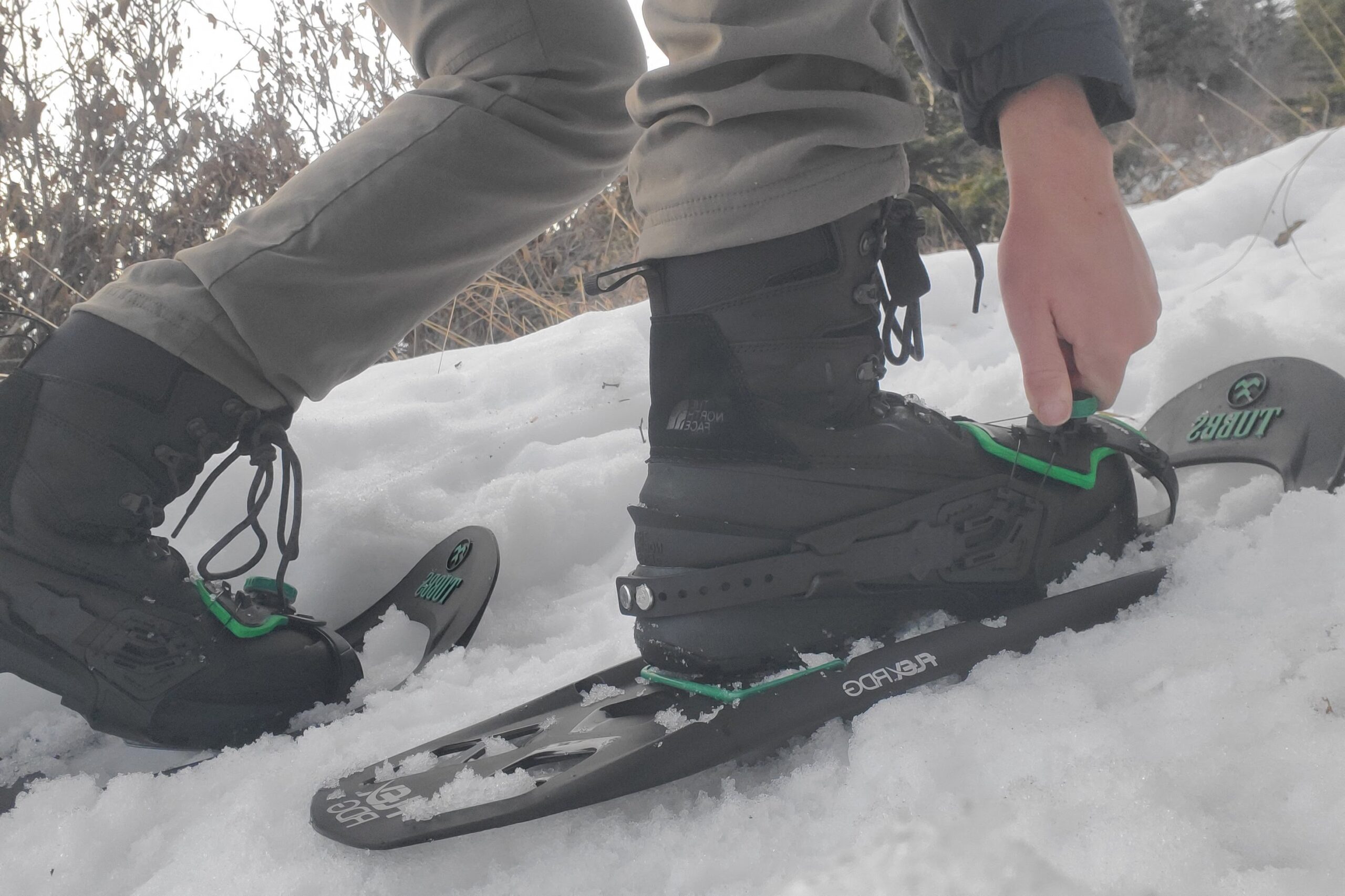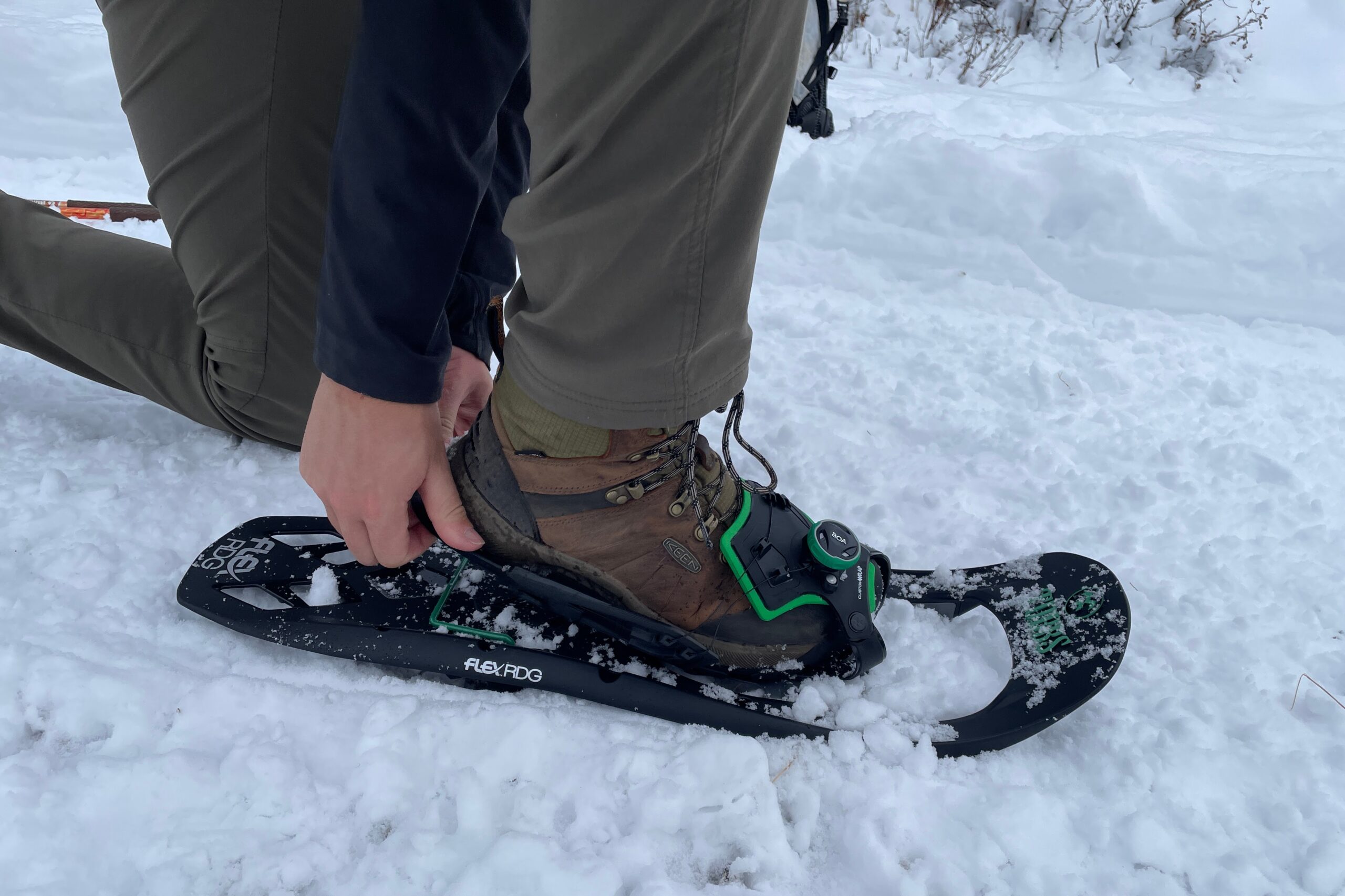Bottom Line
The Tubbs Flex RDG is one of our top-performing snowshoes thanks to its excellent walkability, great traction, and ease of use. We took these on adventures from the foothills to the peaks of Alaska’s Chugach range and found them to be one of the most versatile options on the market.
Their flexible decking provides some of the best walkability of any snowshoe we tested. The deck bends with each step, eliminating the cumbersome clomping of traditional snowshoes. This was especially noticeable when walking downhill where the tails flexed with each step.
Dual parallel traction rails provide excellent traction despite relatively small claws under the forefoot. These dug well into packed and loose terrain. With a slightly smaller surface area than other snowshoes we tested and a large hole in the toe to pivot through, we found that the Flex RDG makes some concessions when it comes to flotation. Regardless, it’s one of the most versatile and well-rounded snowshoes we tested.
Quick Specs

Tubbs Flex RDG
Most walkable snowshoe
Price:
$200
Weight (Pair):
3 lb. 14 oz.(24 in.)
Length:
24”, 28”
Materials:
Powder Coated Steel/Polypropylene
CleverHiker Rating:
4.7
Pros
- Easy to walk in
- Heel lifts
- Easy to use boa bindings
- Lightweight
- Great traction
Cons
- Less flotation in deep snow

Flotation
The Tubbs Flex RDG has a relatively narrow width compared to many other snowshoes we tested. It comes with a large opening in the front for the binding to pivot through and diamond-shaped holes in the tail for decreased weight and flexibility. However, we found that these drastically reduced the snowshoe’s flotation.
The flexible deck that gives this snowshoe its namesake also reduces flotation slightly. When in dense snow, we found the deck curving upward, slightly reducing flotation as the deck gave way and bent. This isn’t noticeable in most situations; however, in deep, wet snow, these snowshoes start to lose their flotation.
We found that these snowshoes excel best in mixed terrain and conditions when venturing from packed trail, to powder and back again. While their flotation may decrease in some of the deepest snow, they are more than enough for most uses and are extremely versatile.

Traction
When kicking steps when climbing up a ridge in Alaska’s Chugach Range, we were immediately impressed with the Flex RDG’s traction. The relatively short claws on the forefoot are aided by large parallel rails of powder-coated steel. These rails were especially effective in climbing steep hills and traversing across slopes. They bit into ice, crust, and deep snow and never felt slippery or insecure. The underside of the deck also features molded brake bars.
While smaller than the traction rails, these small parallel fins of plastic were enough to help aid walking downhill and keep us from sliding out of control. We highly recommend these for a lightweight snowshoe that comes armed with some serious traction.

Walkability
The biggest perk of this snowshoe is its flexible deck that nearly eliminates the clunkiness of traditional snowshoe designs. This is especially evident when walking downhill. When descending, the tails of the snowshoe bend with each foot placement, eliminating the awkward slapping and clomping so common to most other snowshoes. We loved the deck’s flexibility for both steep and rolling terrain.
The shape of these snowshoes doesn’t diminish your agility, which is rare when you might be used to the “tennis racket on your feet” feeling of traditional snowshoes. With a relatively narrow shape, they are one of the narrowest we’ve tested. This allows for a natural stance without any bowlegged feelings. We loved their comfort while walking and spending hours in the snow and mountains.

Ease of Use
Tubbs continues their excellent binding system by incorporating boa technology. This simple dial is one of the most user-friendly snowshoe bindings on the market. Simply pull up on the dial to release them, then pop it down and rotate to tighten. This allows for an extremely snug fit and the ability to adjust to the exact level of tightness desired.
We also loved the heel riser on these snowshoes. This makes hiking uphill comfortable and supported. However, we had trouble deploying and laying down the riser. It is extremely stiff and we had to use two hands instead of a ski pole to raise and lower it.
While using these snowshoes, we noticed an incessant rattle and wiggle through the pivot point on the bindings. Upon further inspection, we found that the bindings pivoted around a single bolt on each side that was very loose. Frustratingly, we could not tighten these down with a socket wrench as the nut was extremely tight while still having lots of play. This is a bit of an annoyance as the foot wiggles and the binding rattles with every step, but so far there seems to be no loss of integrity in the snowshoe’s overall construction.

Should You Buy the Tubbs Flex RDG?
The Tubbs Flex RDG is perfect for those who prioritize versatility in their snowshoes. This snowshoe works well across multiple conditions and can easily go from the trail to the powder. We love the boa system on the binding for ease of use and adjustability. It can’t be beat when it comes to simplicity and keeping your feet secure.
While the snowshoe’s narrow shape makes walking comfortable, we found that these snowshoes concede some flotation for comfort. The flexible deck improves walkability but bends upward in dense snow, sacrificing some flotation. Despite these small shortcomings, the Tubbs Flex RDG stands out to us as a top performer in our lineup of best snowshoes on the market.

What Other Snowshoes Should You Consider?
MSR Lightning Ascent Review – If you love the traction of the Flex RDG but want even more, the MSR Lightning Ascent has some of the best traction in our lineup.
MSR Evo Trail Review – Similarly constructed but in a smaller and lighter frame size, the MSR Evo Trail has parallel bars for traction but is smaller for more maneuverability on the trail and through tight trees.
Retrospec Drifter Review – If you’re looking for another well-rounded snowshoe, the Retrospec Drifter works well across most conditions. At less than half the price of the Flex RDG, it comes at an attainable price point.




